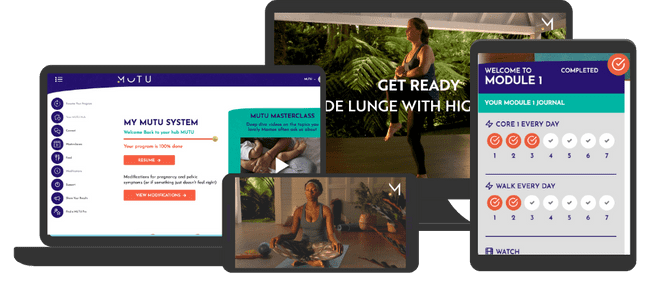Proven in NHS trials to improve symptoms.
Workouts from just 12 minutes a day.
No more anxiety about unpredictable leaks.
Access full support in an expert-led community.
Is MUTU for you?
- You’re tired of wetting yourself a little or dealing with bladder leaks, feeling like there’s nothing you can do.
- You already have so much on your plate, and you’re fed up feeling out of control and want to be back to feeling strong.
- You’ve been using period pants, pads, or just changing your underwear to manage it. There’s no shame in this, but you don’t want to manage it like this forever.
- Friends, even doctors, say you just have to put up with peeing a little after childbirth. You believe it’s too late, hopeless, or will take too much effort to fix it.
- You’re doing your best. There’s just no time to figure out what you’re supposed to do or to fit it all in.
10-day, no-obligation free trial. Then £140 for 12-month access.
Or £21 every month
Watch to find out if MUTU is for you!

Join Our Expert Community
10 Day Free Access
See and feel the benefits of the MUTU programme first hand with 10 days access. Experts guide you on the first steps of your journey to pelvic floor strength.
No obligation, cancel anytime in your trial period.
For the first 10 days of your pelvic strength journey, you have full access to the first 4 Modules of the MUTU programme. You’ll also get access to expert support in our private community.
Full membership access following the trial.

Full membership
- Evidence-based, proven exercises in easy-to-follow videos that take from just 12 minutes a day
- Safe progression to more challenging exercise and movement
- Recommended by NHS Women’s Health physiotherapists, Urology surgeons and GPs
- Video instructions and personal progress tracker. Get support from MUTU experts and other mums in the membership forum
- Clear instruction and modifications for pelvic floor issues, pelvic organ prolapse and pregnancy
- The MUTU community is welcoming, inclusive and judgment-free!
10-day, no-obligation free trial. Then £140 for 12-month access.
Or £21 every month

What mamas say about MUTU
96% of women who had experienced bladder symptoms or urinary leakage, saw improvement within 6 weeks of using MUTU System
*100 women in trials with NHS Hospital Trust 2020

“I'm half way through the programme and the results have been astounding. I'm able to pick up my 27 lb son with ease, no more sneezing and leaking. And on top of strength, in noticing a change in my hangover belly post C section and a very large baby.”
Shawna

“I am sporty and want to get back to exercise confidently without leaks. This programme has allowed me to focus on my pelvic floor and I have made massive improvements. I can jump on a trampoline with the kids or sprint without worrying.”
Melanie

What NHS Doctors say about MUTU

“I highly recommend MUTU System as safe and effective. The exercises are evidence-based and shown to deliver significant benefits for incontinence symptoms”
Dr Jai Seth, Consultant Urology Surgeon

“The MUTU programme has impacted the lives of so many women in my practice. I am glad the NHS have clearly identified the value in MUTU’s transformational programme!”
Dr Odinake Nwodo, GP and Urology clinician

Why are TENA and MUTU working together?
- 70% of new MUTU members start with urinary incontinence, bladder control or bladder leak issues.
- Postpartum bladder leaks are common but treatable. Whether you’re a new mum or experiencing perimenopause, we’re here to help you fix the problem, not just manage it.
- TENA pads and pants offer effective short-term management, providing dignity and comfort while you work on a long-term solution with MUTU’s exercises and techniques.
- With MUTU, you’re treating incontinence, not just managing it. Our partnership with TENA ensures you have the support you need every step of the way.
- No taboos, no shame. Just informed, evidence-based solutions.
Answers to your FAQs
What is a kegel exercise?
A kegel exercise is when you contract (squeeze) the muscles of your vagina, anus, and urethra (separately or together) and then release them. Men can do kegels too by contracting their perineal muscles.
The ideal kegel is when you can squeeze and release your vaginal muscles, and then gently release them beyond their normal resting spot. A common cue is to imagine there are ten elevator levels you are ascending and descending – with an extra floor at the base while you contract and release. Work slowly, with control, and without force or breath-holding.
Side note: Like far too many things in women’s health, this exercise is named after a guy who ‘invented’ them.
What are kegels good for?
Kegels after birth can be great for reconnecting with the muscles and organs in your pelvic area. You’re working to regain control and confidence in your body.
As part of a bigger picture of integrating core restoration, strength, emotional and sexual health, Kegels can definitely help!
Is doing Kegels during pregnancy worth it? Understanding the benefits for birth
Can you do kegels whilst pregnant? Yes they can be a good exercise to practice in preparation for birthing unless you typically have a tight pelvic floor. Just as much as having physical strength in this area is great for birth, being able to be aware of how these muscles work and feel like you have some control over them can be a great tool when it comes time to push your baby out.
If you are planning on having a cesarean birth, Kegels can still help reduce your chances of post-surgery complications and the pelvic floor strain that happens during pregnancy.
Are Kegels after birth good? And can Kegels postpartum be a healthy part of your recovery?
If done correctly, Kegels after birth can be a healthy part of postpartum recovery. For a lot of women, it can feel good to connect with your vagina through these exercises but don’t worry if you can’t feel much at first. You may be numb and tender, so take your time and be patient as healing progresses.
If you had stitches, or a birth with forceps or a vacuum, tenderness is present, so just take your time.
Can Kegels be bad for you? Risks and considerations you should know
Kegels can be counterproductive if you feel too tight in your pelvic floor. You’d know this if sex becomes painful, if you have difficulties starting a stream of pee, if you are maybe having more UTIs, or if you are starting to have pelvic muscle spasms. What’s happening is that you are over-pulling the tissues in your pelvic brim, which shortens them and can actually make them weaker.
If you know you have a tight pelvic floor, it could be more helpful to practice relaxing, breathing, and stretching your pelvic floor muscles before birth instead of doing a lot of squeezing. Sitting in a low squat, using your breath to relax your pelvic floor, and visualizing more space and openness there can do a surprising lot to help! It sounds a little woo-woo, but it’s backed by evidence.
Kegels are not recommended if you have Hypertonic Pelvic Floor disorder. Check out this article on hypertonic pelvic floor to learn about the symptoms, causes, and treatments for this issue.
Can pelvic floor exercises improve bladder control?
Yes! The best way to start reducing leaks and regain bladder control is to do your pelvic floor exercises daily. It’s an effective way to strengthen your pelvic floor muscles, improving overall coordination and connection to the area.
We understand that feeling like you’ve lost control of your bladder can cause anxiety and a lack of confidence. But even though it is very common, we want you to know it’s not normal, you don’t have to tolerate it, and with the correct exercises you can fix it and feel like you again.
Will MUTU work for me?
However long ago you had your babies, if you want to feel more confident in your body… YES, it will.
For your reassurance: Medical evidence and customer feedback for MUTU include hospital clinical trials, international medical approval, and a 900-participant clinical survey with incredible results, along with thousands of 5-star customer reviews.
- Results from clinical trials with a University Hospital during COVID were off the scale, reported across press and on BBC TV.
- Rated ‘Excellent’ and 5 stars by thousands of customers worldwide on Trustpilot, Google, and Facebook.
- MUTU is the only core and pelvic floor complete recovery programme fully approved by NHS Digital in the UK.
A clinical survey of over 900 US and UK customers in 2018 also showed:
- 94% of women with diastasis recti (abdominal separation) reported an improvement
- 97% of women who were unable to successfully locate and engage their pelvic floor muscles could do so after 3 weeks of MUTU
- 92% of women who experienced bladder symptoms including urinary leakage reported an improvement
- 88% of women who experienced symptoms of pelvic organ prolapse reported an improvement
- 94% of women felt an improvement in how they felt about their body and what it is able to do
- 89% of women who experienced pain or discomfort during/after intercourse reported an improvement.
No other programme or solution comes close. We’ve got you!
How long will it take to work?
You should start to feel the difference after 4 modules and really start to see changes within 6-8 modules. The more mindfully and consistently you follow the programme, the quicker and more noticeable your results will be!
I don’t have much time. How long do the exercises take?
MUTU is specifically designed to fit into a busy mum’s schedule.
MUTU Core workouts take just 12 minutes every day.
MUTU Intensive workouts take around 22 minutes (3 times a week).
I had my babies years ago — am I too late?
It’s never too late to make a difference — to get a stronger lower back, a more optimally functioning core and pelvic floor, and stronger abs. It doesn’t matter how long ago you had your last baby — MUTU can help.
We’ve got you, wherever you are on your motherhood journey.
How soon after delivery/c-section can I start Mutu?
You can start MUTU Core™️ as soon as you feel able. MUTU Core is specifically designed to be safe to start even in the early days after delivery (including c-section), and a daily walk will aid circulation and healing.
You can start to progress with the MUTU Intensives™️ 6 weeks after vaginal birth, or 10 weeks post c-section or complications, with your Doctor’s consent. You’ll be guided within the programme to safely progress to the MUTU Intensive™️ workouts in line with your recovery.
As with any exercise programme during pregnancy or shortly after childbirth, you should consult with a medical professional to be sure exercising is safe for you.
I also have Pelvic Organ Prolapse. What exercises are safe? How should I modify regular exercises?
MUTU is safe and recommended for you if you are coping with prolapse symptoms. Clear modifications and guidance are given throughout the programme.
MUTU is clinically proven to improve prolapse symptoms.
An independent clinical survey of over 900 customers in 2018 showed that 88% of women suffering from Pelvic Organ Prolapse reported an improvement after following MUTU. Clinical trials in 2020 showed that an incredible 100% of women suffering from prolapse symptoms saw improvement within 3 weeks of using MUTU.
Is MUTU an app?
Yes, MUTU System is a web app. That means it works great on your phone or tablet… or on your laptop, smart TV, or any other streaming device! Use MUTU however works best for you.
You don’t need to download anything extra from the app store – simply sign up for your free trial and then follow the instructions to add the MUTU Mamas website to your device’s home screen.
Is MUTU safe for pregnancy?
Yes. MUTU is recommended by doctors, midwives, and physiotherapists as safe throughout your motherhood journey. It is safe to exercise during pregnancy, and there are proven and meaningful benefits.
The most important core exercises you can do in pregnancy are the foundational core and pelvic floor exercises found in MUTU Core. These highly effective breathing strategies guide you to tune in and intentionally connect with your deep core and pelvic floor.
These specific core exercises during pregnancy will help establish familiarity and connection with what it feels like to engage your core and your pelvic floor correctly. This will serve you during labour, and will help post-birth (whether you have a c-section or vaginal delivery) when abdominal muscles and/or pelvic floor muscles may be tender, numb, traumatised, or lacking in sensitivity.
The Royal College of Obstetricians and Gynecologists (RCOG) encourage all pregnant women (with clearance from their Doctor and no contraindications) to exercise moderately for around 20 minutes every day. This level of exercise offers very meaningful health benefits and reduces the risk of pregnancy complications. This includes women who didn’t exercise before they were pregnant.
Where do I log in?
Login HERE.
You will receive your login details a few minutes after you purchase MUTU System.
What equipment do I need?
A resistance band, a resistance band loop, and a small inflatable ball. A strong cotton strap is also helpful for those all-important stretches at the end of your workout.
To make life easy, we’ve put together a kit bag containing all of these items. You can purchase this during the free trial sign up, or later, direct from the membership site.
You’ll also need a mat or somewhere comfortable to lie down for some of the exercises. Some pillows or rolled-up blankets would also come in handy to get comfy in certain moves/stretches.
What do I get?
You get… everything you need to gain confidence in how your body looks, works and feels, wherever you are in your motherhood journey.
Join now and log in for full access to:
- 24/7 access to your exclusive, secure MUTU Mamas Community
- Weekly community check-in from a real-life dedicated MUTU Expert (no Bots here!) to answer all your questions
- MUTU Core workout videos – fully guided and instructed real-time videos of core and pelvic floor rehabilitation techniques
- MUTU Intensive workout videos – clearly instructed real-time videos of no-impact, but high intensity, DR-safe, efficient workouts to strengthen, shape, and tone
- Posture and biomechanics video instruction
- Motivational digital online progress tracker and journal
- Text or email alerts (you choose!) to keep you on track
- Unrivalled personal support and ‘Digging Deeper’ guidance if you need extra help
- Regular bonus workouts
- Pregnancy and Prolapse modification instruction
- MUTU Food guide – healthy and family-friendly
- Additional medical resources

10-day, no-obligation free trial. Then £140 for 12-month access.
Or £21 every month











